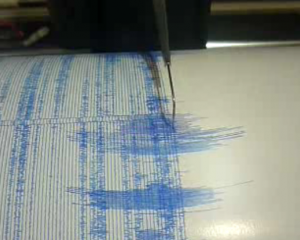Although the alpine fault is "well behaved", scientists say there is a 30% chance of a large earthquake along the fault over the next 50 years.
A four-year study into the fault, which stretches 600km along the spine of the South Island, from Marlborough in the north to Milford Sound in the south, has given scientists a greater knowledge of how often the fault ruptures.
When it ruptures it can produce earthquakes of about magnitude 8 on the Richter scale.
The investigation, which was centred on a remote river terrace near Lake McKerrow, about 35km northeast of Milford Sound, and supplemented with information from the Haast area, found evidence of 24 surface ruptures of the alpine fault dating back to 6000BC.
Previously, scientists have only been able to date four earthquakes along the fault dating back to about AD1000.
Scientists found the mean interval between large earthquakes on the fault was 330 years and two-thirds of the intervals were between 260 and 400 years.
The longest gap without a major quake was 510 years, while the shortest was 140.
Dr Kelvin Berryman, manager of the Natural Hazards Research Platform at GNS Science, said it was probably only the fifth fault in the world to have such a long record of documented quakes.
The findings would greatly improve the reliability of earthquake-hazard modelling and were particularly significant in Canterbury.
"The findings are being incorporated in liquefaction and earthquake shaking mitigation measures as part of the rebuilding process.
"Based on this research, scientists have estimated there is a 30% probability of a large earthquake on the alpine fault in the next 50 years. This is at the higher end of existing estimates, which are based on only the last four large quakes on the fault."
He emphasised this was not the prediction of an earthquake, and a big earthquake might, in fact, not be imminent.
The mean recurrence interval between the 24 earthquakes was about 330 years. Given there had been about 295 years since the last big quake, a major earthquake in the near future would not be a surprise.
Equally, a quake could be up to 100 years away, but "a precautionary approach is certainly warranted".
Although scientists had found a fault "that responds to the steady motion of tectonic plates by rupturing at reasonably regular intervals", this did not mean researchers could predict when a fault rupture would occur.
Project co-leader Ursula Cochran, also of GNS Science, said the long earthquake record highlighted the inevitability of a major earthquake occurring on the southern section of the alpine fault in the future.
Dr Virginia Toy, of the University of Otago geology department, said this study had extended previous research involving Otago University geologists, including Prof Richard Norris who had also undertaken previous research with Dr Berryman.
The latest research had strengthened earlier findings of regular earthquake cycles, by greatly extending the time period covered by the analysis, but further research on the effect of the quakes was also needed, Dr Toy said.
Prof Norris said the study was of national and international significance.
"The alpine fault has the highest level of probability for rupture of any fault in New Zealand," he said.
"Westland, obviously, is at high risk, with widespread damage likely and roads, bridges and other transport links likely to be badly affected [and the tourist trade].
"Intensities further east in places such as Queenstown, Te Anau, Wanaka and Mt Cook will be high enough to cause landslips and do damage.
"Further east, in the major cities of Christchurch and Dunedin, the intensities will be lower but the duration of shaking could still be sufficient to damage poorly constructed buildings ...and possibly cause some liquefaction."




